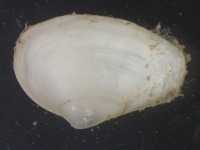
(Photo: Huntsman Marine Sience Centre)
Soft-Shell Clam
Mya arenaria
Bivalve with an oval-shaped shell. Up to 15 centimetres in diameter. It is generally white with greyish tones. Shell is thin and breaks easily (hence the common name). It has noticeable concentric rings. In dead specimens, the chondrophore is an identifying feature. This is a plate-like, calcareous structure attached to the hinge of the left valve inside the shell.
Authority
Linnaeus, 1758
Classification Details
Phylum: Mollusca (molluscs); Class: Bivalvia (bivalve molluscs).
Habitat
Native to the northwest Atlantic. Present all along the east coast of North America, from northern Canada to the southern states. They can live in waters as warm as 28°C. They are also found in the eastern Atlantic and the North Sea. Invasive on the Pacific coast of North America. They burrow below the surface in sand and mud sea beds where they bury up to 20 centimetres below the surface. Found from the lower shore down to around 20 metres deep. Can be very common in estuaries.
Diet
Soft-shell clams are filter feeders. They feed on phytoplankton, small zooplankton, diatoms, and other small particles. They extend a long, fused siphon (up to 40 centimetres long) to the sediment surface to pump in water. They then filter out particles using their gills. The siphon makes a distinctive key-hole shaped opening in the seabed.
Reproduction
Sexes are separate. External fertilization. Have one or two spawning events per year in spring and summer, when temperatures are between 10°C and 15°C. Males release sperm in the water and this triggers females to release eggs (as many as one to three million!). After hatching, the larval phase lasts for two to three weeks before larvae settle to the seabed as tiny clams 0.2 millimetres long. The young clams spend two to five weeks at the seabed surface before burrowing. Adults usually live for 10 to 12 years, but scientists recorded individuals as old as 28 years in the Bay of Fundy.
Fun Facts
Soft-shell clams are a popular food in Canada and America. They are a key component of the New England clam bake where people cook them on the beach by steaming them in seaweed.
The original European populations of this species became extinct over 2.58 million years ago. Scientists have shown (using stable isotope analysis) that this species was then re-introduced to Europe from the northwest Atlantic in the 13th century. They think that Vikings may have brought them back with them. This would support the view that Vikings explored North America before Columbus.
References
Essink K, Oost AP, Streurman HJ and Van Der Plicht J (2017) Are Medieval Mya arenaria (Mollusca; Bivalvia) in the Netherlands also clams before Columbus? Geologie En Mijnbouw 96, 9–16. Global Invasive Species Database (2020) Species profile: Mya arenaria. http://www.iucngisd.org/gisd/species.php?sc=1159 Accessed online 22 January 2020. Jensen KR (2010) NOBANIS – Invasive Alien Species Fact Sheet – Mya arenaria – From: Identification key to marine invasive species in Nordic waters https://www.nobanis.org/globalassets/speciesinfo/m/mya-arenaria/mya-arenaria.pdf Accessed online 22 January 2020. Ropes JW and Stickney AP (1965) Reproductive Cycle of Mya arenaria in New England. The Biological Bulletin 128, 315–327. Tyler-Walters H (2003) Mya arenaria Sand gaper. In Tyler-Walters H. and Hiscock K. (eds) Marine Life Information Network: Biology and Sensitivity Key Information Reviews, [on-line]. Plymouth: Marine Biological Association of the United Kingdom. Available from: https://www.marlin.ac.uk/species/detail/1404 Accessed online 22 January 2020.

